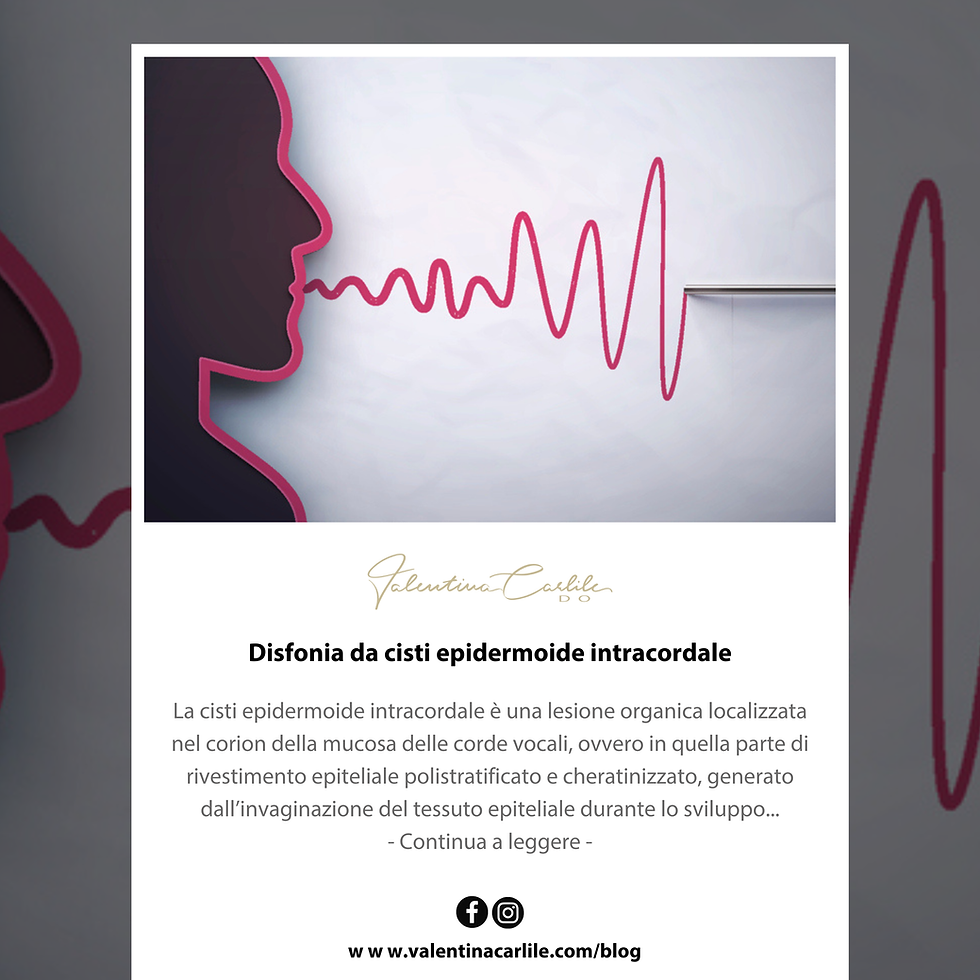Osteopathy and Voice: Post-surgical Reinke's Edema, History of L.
- Valentina Carlile DO

- Nov 9, 2015
- 3 min read

L., a 79-year-old woman, went to the office of a speech therapist with whom I collaborate for a vocal evaluation sent by her otolaryngologist. The complaints were: continuous vocal strain, hoarseness and loss of voice after surgery for Reinke's edema.
As reported, L. she had for two months a worsening hoarseness with moments of interruption of voice, lowering of voice, more serious tones, inability to speak aloud when she decided to contact her ENT. She was diagnosed with Reinke's edema which involved immediate stripping of both vocal cords about a month before our consultation.
Before the surgery L. she had not been referred to a speech therapist, nor after. She was only advised to stay at full vocal rest for 2 full days after surgery.
When she then resumed speaking she realized that there was aphonia and again, an important hoarseness and it tended to get worse as she L she used her voice.
A new laryngoscopic inspection performed 1 week prior to our consultation revealed progress in chordal healing with residual swelling of both cords.
At this point, the ENT recommended speech therapy.
Before the surgery L. she had a 45-year history of smoking (1 pack / day) and she never stopped. Caffeine intake was estimated at 4 coffees / day. The intake of caffeine-free fluids was good. L. she took and still takes antihypertensive drugs. She did not drink and does not drink alcohol. No laryngeal reflux symptoms, no allergic episodes.
L. started working at the age of 10. She is married and now she doesn't work anymore. She has reported various episodes of marital stress that were made worse by her vocal problems occurring in conjunction with her husband's hearing loss, which negatively impacted their ability to communicate with each other.
When she came for a consultation with the speech therapist with whom I collaborated, he immediately worked on a new and updated vocal evaluation. The range around the fundamental frequency covers a range of 114-380Hz, about 14 full notes, which is below normal limits.
The Speaking Fundamental Frequency SFF was estimated at 131Hz but fluctuating.
Perceptually, on a 5-point severity scale, the level was 3, corresponding to a moderate deviation. The SFF is outside the normal limits for age and gender. The disturbance frequency was 5.41, a value that well exceeds the normal limits and leads to an evaluation of dysphonic voice.
On a 5-point severity scale (GRBAS), hoarseness was rated 4 (moderate-severe) and puffiness 2 (mild-moderate). There were often interruptions in the voice and harsh glottal strokes. Overall, the item was rated 4 as a severity level (moderate-severe).
The tone of voice was appropriate for the room in which the assessment was made but faded as she spoke. The moment she tried to turn up the volume her screeching increased.
Then examining the abdominal breathing it was found that the maximum duration of phonation for a / a / was 12 seconds, which is normal for age and sex. The / s / and the / z / instead were 20sec and 13sec which instead do not fall within the limits.
For L. these were excessive and difficult efforts: shouting and laughing, talking and screaming, talking too much, coughing and clearing his throat.
The subjective evaluation of L. was then applied with the VHI scale (Voice Handicap Index) which aims to study the impact caused by the voice in three areas: physical, emotional and functional. The evaluation gave a result 76/120 distributed as follows: 27/40 physical, 25/40 emotional, 24/40 functional.
The resonance and articulation were normal without dysarthria.
At this point, the speech therapist and I prepared a therapy that included some indications, exercise and osteopathic treatment. Specifically, L. was invited to speak in a way that is comfortable for her, and without whistling. She was advised to perform 'humming' exercises (with the letter / m /) several times throughout the day, trying to feel the vibrations in the mouth and at the level of the nose, to try to lower and return the larynx to neutral. Osteopathically a global evaluation of the patient was made which led to the reduction of some functional 'dysfunctional' patterns and specifically laryngeal techniques were performed that in static and in dynamics (using also and vocals as for pneumophonic agreement) aimed at making the most the laryngeal system is integrated and functional in its descent and ascent components and the anterior and posterior bascule, all with constant monitoring of the phonatory tripod (C0-hyoid-mandible) and its implications with the descending visceral tractions.
After 2 and a half months of therapy with treatments at intervals of 15-20 days L. has recovered her vocal functionality and still today (after 6 months) she is able to relate peacefully.





Comments